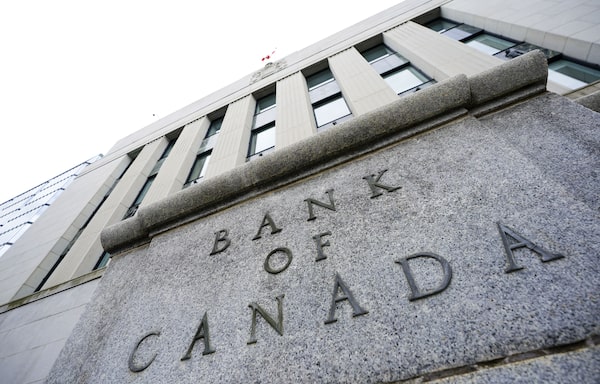
The Bank of Canada in Ottawa on July 12.Sean Kilpatrick/The Canadian Press
The Bank of Canada is looking for part-time help. And it’s a pretty big deal.
On a lazy late-August afternoon, the central bank issued a news release announcing the launch of its search for a new deputy governor. On the surface, this was no big surprise; veteran deputy Tim Lane had announced his retirement earlier in the summer, effective Sept. 22, creating a vacancy. An announcement about the search for his replacement would normally just be a bit of standard housekeeping.
But this help-wanted ad came with a twist – one that makes this the most noteworthy deputy governor search in decades.
The bank has decreed that this new deputy governor – one of the six people who form its governing council, which sets monetary policy for the country – must be an outsider. Someone from a walk of professional life other than central banking.
What’s more, the newcomer won’t be burdened with the management duties of the other deputy governors, who each oversee various departments within the bank. (Hence the part-time status.) This “non-executive” deputy governor, as the bank has termed it, will focus her or his attentions strictly on the core functions of the governing council: helping set monetary policy (chiefly, interest rates) with an eye on controlling inflation and fostering stability in the financial system.
This non-executive outsider will be limited to a two-year term, with an option for both parties to extend it to three. Until now, deputy governors have had no term limits; the retiring Mr. Lane, for example, has held his post for nearly 14 years. (The governor and senior deputy governor have seven-year terms, and can apply for reappointment to a second term.)
Why should any of this matter? Because coming out of one of the most tumultuous periods in central banking history – one in which the bank’s decisions around monetary policy and its grip on inflation have come into serious question – the Bank of Canada has decided it wants to add a new kind of voice to its decision-making. One that comes from outside the echo chamber of the bank.
This is the first significant change to the makeup of the governing council since it was set up by then-governor Gordon Thiessen in 1994.
Mr. Thiessen’s idea was to depersonalize monetary policy away from the governor, after his predecessor, John Crow, had become a controversial figure who clashed with the government and was all but escorted to the door when his term ended. While by law the governor has final say in setting policy, the governing council was meant to create a collaborative process in which, in practice, decisions are reached by consensus within the council. The central bank has operated that way in the nearly 30 years since.
The bank hasn’t said precisely what prompted this move to inject something new and different into that structure. (When we asked, a bank spokesperson directed us to the statement from Governor Tiff Macklem in the news release: “This change provides an opportunity both to bring fresh and diverse perspectives into the bank’s consensus-based policy decision-making framework, and to ensure the bank’s executive team has a balanced, streamlined and effective distribution of management responsibility.”)
But it’s easy to imagine that the bank’s senior brass has been taking a hard look in the mirror regarding its policy decisions since the beginning of the pandemic – particularly over the past year, when it unquestionably misread the nature, strength and staying power of inflationary forces. Monetary policy makers, both within the Bank of Canada and throughout the world of central banking, were guilty of group-think that confirmed their own beliefs and biases. That may have contributed to slow recognition of the problem and, initially, a delayed response once the seriousness of the threat sunk in.
The new Bank of Canada position looks to have some similarities to the model at the Bank of England, whose nine-member monetary policy council includes four “external” appointees on three-year terms (the deputies from within the bank have 10-year terms). New Zealand’s central bank also has several external members on its policy committee.
It’s debatable whether these outside voices made any meaningful difference to the recent course of policy, which has been no less rocky for those two central banks. The British inflation rate topped 10 per cent in July, and was already over 5 per cent before the Bank of England started raising rates last December. In New Zealand, the Official Opposition in Parliament has called for an independent inquiry into the bank’s actions in the COVID-19 crisis and its response to inflation.
And frankly, looking at the qualifications listed in the Bank of Canada’s official job posting, it’s hard to see how the bank will end up with someone with a dramatically different background than the economists and researchers already at the central bank. The posting says the successful candidate “must possess the economics knowledge, skills, experience and understanding of central banking necessary to contribute to monetary policy decisions.”
That’s not quite the same as being at the central bank, but it suggests someone in pretty close orbit.
Still, the bank’s news release says that it will seek “outstanding candidates from a broad range of disciplines and backgrounds.” That does suggest some hope that the bank genuinely wants to unearth a new deputy governor who thinks outside the central banking box. Maybe there’s an innovative business leader, or researcher, or public policy advocate who can provide the governing council a fresh lens to apply to its monetary policy.
Or a smart-guy columnist who makes his living armchair-quarterbacking Bank of Canada decisions. Hey, now there’s a thought.
Your time is valuable. Have the Top Business Headlines newsletter conveniently delivered to your inbox in the morning or evening. Sign up today.